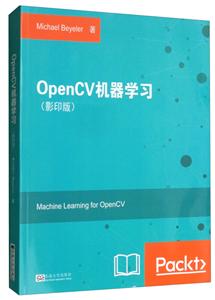-
>
全國計算機等級考試最新真考題庫模擬考場及詳解·二級MSOffice高級應用
-
>
決戰行測5000題(言語理解與表達)
-
>
軟件性能測試.分析與調優實踐之路
-
>
第一行代碼Android
-
>
JAVA持續交付
-
>
EXCEL最強教科書(完全版)(全彩印刷)
-
>
深度學習
OpenCV機器學習 版權信息
- ISBN:9787564183240
- 條形碼:9787564183240 ; 978-7-5641-8324-0
- 裝幀:一般膠版紙
- 冊數:暫無
- 重量:暫無
- 所屬分類:>
OpenCV機器學習 內容簡介
《OpenCV機器學習(影印版)》首先介紹了統計學習的基本概念,例如分類和回歸。介紹完所有的基礎知識之后,就開始探究如決策樹、支持向量機、貝葉斯網絡等算法,學習如何將它們與其他OpenCV功能綜合運用。你的機器學習技能會隨著書中內容的進度一同提高,直到準備好學習當前熱門的主題:深度學習。在《OpenCV機器學習(影印版)》的結尾,你可以根據現有的源代碼構建或是從頭開發自己的算法來解決自己碰到的機器學習問題!
OpenCV機器學習 目錄
Chapter 1:A Taste of Machine Learning
Getting started with machine learning
Problems that machine learning can solve
Getting started with Python
Getting started with OpenCV
Installation
Getting the latest code for this book
Getting to grips with Python's Anaconda distribution
Installing OpenCV in a conda environment
Verifying the installation
Getting a glimpse of OpenCV's ML module
Summary
Chapter 2: Working with Data in OpenCV and Python
Understanding the machine learning workflow
Dealing with data using OpenCV and Python
Starting a new IPython or Jupyter session
Dealing with data using Python's NumPy package
Importing NumPy
Understanding NumPy arrays
Accessing single array elements by indexing
Creating multidimensional arrays
Loading external datasets in Python
Visualizing the data using Matplotlib
Importing Matplotlib
Producing a simple plot
Visualizing data from an external dataset
Dealing with data using OpenCV's TrainData container in C++
Summary
Chapter 3: First Steps in Supervised Learning
Understanding supervised learning
Having a look at supervised learning in OpenCV
Measuring model performance with scoring functions
Scoring classifiers using accuracy, precision, and recall
Scoring regressors using mean squared error, explained variance, and R squared
Using classification models to predict class labels
Understanding the k-NN algorithm
Implementing k-NN in OpenCV
Generating the training data
Training the classifier
Predicting the label of a new data point
Using regression models to predict continuous outcomes
Understanding linear regression
Using linear regression to predict Boston housing prices
Loading the dataset
Training the model
Testing the model
Applying Lasso and ridge regression
Classifying iris species using logistic regression
Understanding logistic regression
Loading the training data
Making it a binary classification problem
Inspecting the data
Splitting the data into training and test sets
Training the classifier
Testing the classifier
Summary
Chapter 4: Representing Data and Engineering Features
Understanding feature engineering
Preprocessing data
Standardizing features
Normalizing features
Scaling features to a range
Binarizing features
Handling the missing data
Understanding dimensionality reduction
Implementing Principal Component Analysis (PCA) in OpenCV
Implementing Independent Component Analysis (ICA)
Implementing Non-negative Matrix Factorization (NMF)
Representing categorical variables
Representing text features
Representing images
Using color spaces
Encoding images in RGB space
Encoding images in HSV and HLS space
Detecting corners in images
Chapter 5: Using Decision Trees to Make a Medical Diagnosis
Chapter 6: Detecting Pedestrians with Support Vector Machines
Chapter 7: Implementing a Spam Filter with Bayesian Learning
Chapter 8: Discovering Hidden Structures with Unsupervised Learning
Chapter 9: Using Deed Learning to Classifv Handwritten Diqits
Chapter 10: Combining Different Algorithms into an Ensemble
Chapter 11:Selecting the Right Model with Hyperparameter Tuning
Chapter 12: Wrapping Up
OpenCV機器學習 作者簡介
邁克爾·貝耶勒是華盛頓大學神經工程和數據科學專業的博士后,主攻仿生視覺計算模型,用以為盲人植入人工視網膜(仿生眼睛),改善盲人的視覺體驗。他的工作屬于神經科學、計算機工程、計算機視覺和機器學習的交叉領域。他也是2015年Packt出版的《OpenCV with Python Blueprints》一書的作者,該書是構建高級計算機視覺項目的實用指南。同時他也是多個開源項目的積極貢獻者,具有Python、C/C++、CUDA、MATLAB和Android的專業編程經驗。他還擁有加利福尼亞大學歐文分校計算機科學專業的博士學位、瑞士蘇黎世聯邦理工學院生物醫學專業的碩士學位和電子工程專業的學士學位。當他不“呆頭呆腦”地研究大腦時,他會攀登雪山、參加現場音樂會或者彈鋼琴。
- >
二體千字文
- >
我與地壇
- >
上帝之肋:男人的真實旅程
- >
伯納黛特,你要去哪(2021新版)
- >
山海經
- >
羅庸西南聯大授課錄
- >
中國人在烏蘇里邊疆區:歷史與人類學概述
- >
煙與鏡

















